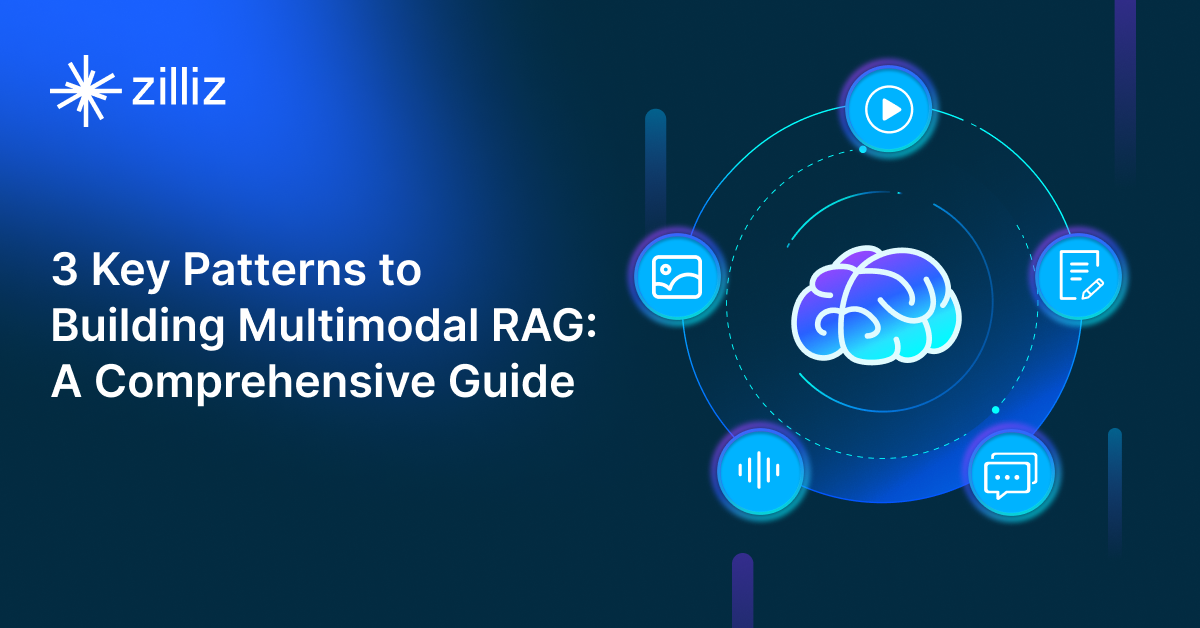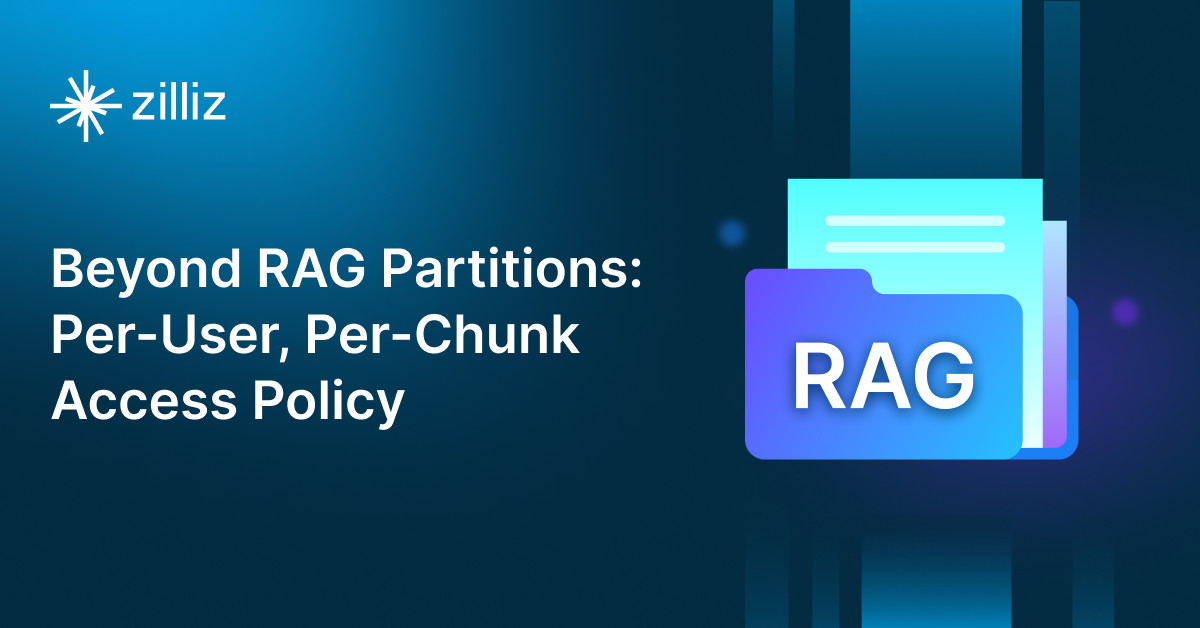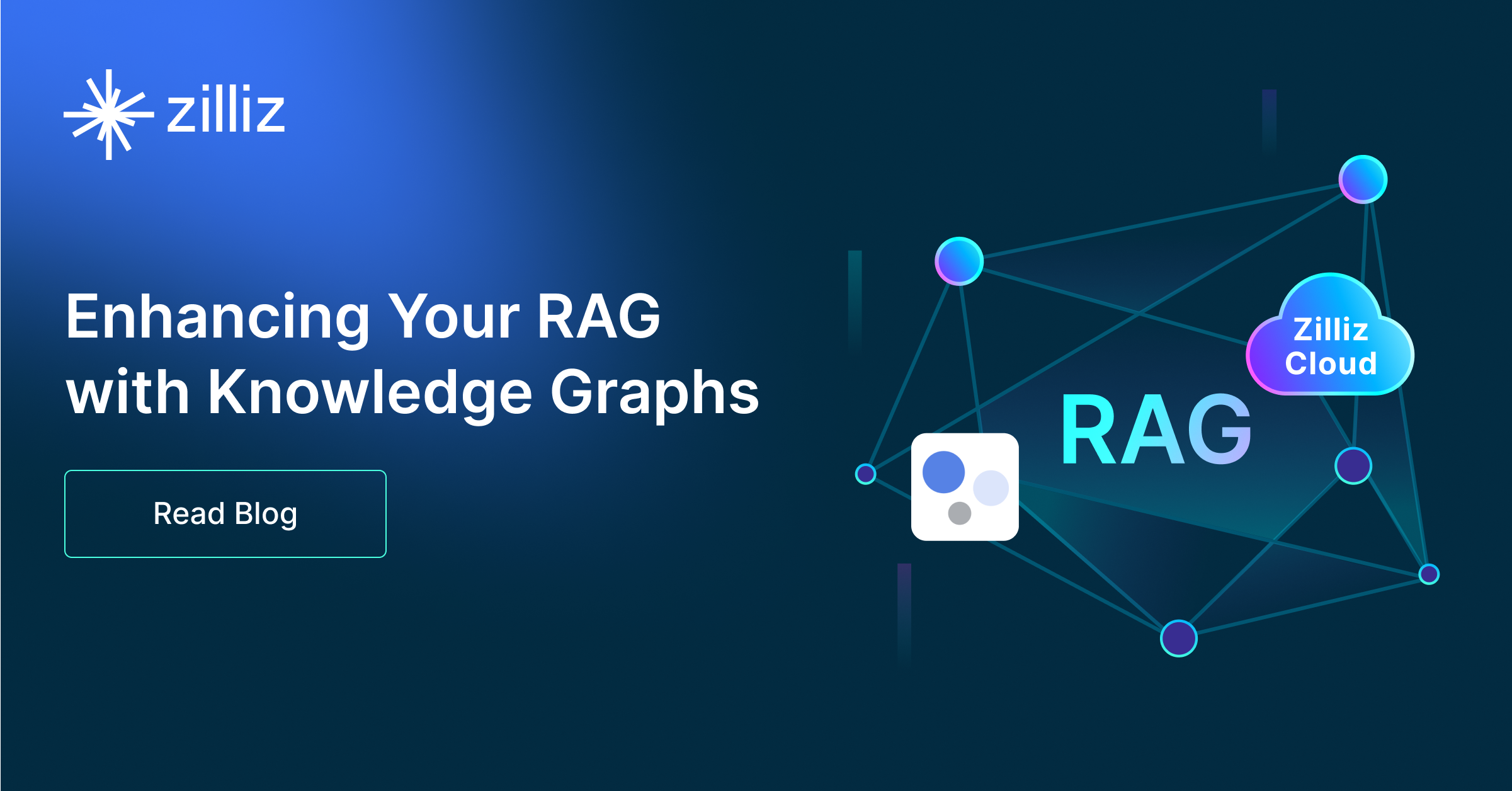Build RAG Chatbot with LangChain, LangChain vector store, Google Vertex AI Claude 3.7 Sonnet, and Amazon Titan Text Embeddings v2
Introduction to RAG
Retrieval-Augmented Generation (RAG) is a game-changer for GenAI applications, especially in conversational AI. It combines the power of pre-trained large language models (LLMs) like OpenAI’s GPT with external knowledge sources stored in vector databases such as Milvus and Zilliz Cloud, allowing for more accurate, contextually relevant, and up-to-date response generation. A RAG pipeline usually consists of four basic components: a vector database, an embedding model, an LLM, and a framework.
Key Components We'll Use for This RAG Chatbot
This tutorial shows you how to build a simple RAG chatbot in Python using the following components:
- LangChain: An open-source framework that helps you orchestrate the interaction between LLMs, vector stores, embedding models, etc, making it easier to integrate a RAG pipeline.
- LangChain in-memory vector store: an in-memory, ephemeral vector store that stores embeddings in-memory and does an exact, linear search for the most similar embeddings. The default similarity metric is cosine similarity, but can be changed to any of the similarity metrics supported by ml-distance. It is intended for demos and does not yet support ids or deletion. (If you want a much more scalable solution for your apps or even enterprise projects, we recommend using Zilliz Cloud, which is a fully managed vector database service built on the open-source Milvusand offers a free tier supporting up to 1 million vectors.)
- Google Vertex AI Claude 3.7 Sonnet: Google Vertex AI Claude 3.7 Sonnet: Google’s Vertex AI integrates Claude 3.7 Sonnet, bringing advanced NLP capabilities to the Google Cloud ecosystem. It supports the creation and deployment of secure, customized language models with high precision in natural language understanding and generation. Ideal for enterprises looking to leverage AI for chatbots, document processing, and AI-assisted customer interactions with a focus on scalability and cloud-native solutions.
- Amazon Titan Text Embeddings v2: This model generates high-quality text embeddings, enabling nuanced semantic understanding and similarity comparisons. It boasts enhanced performance and scalability, making it suitable for tasks such as information retrieval, recommendation systems, and sentiment analysis. Ideal for applications needing robust and efficient language representation at scale.
By the end of this tutorial, you’ll have a functional chatbot capable of answering questions based on a custom knowledge base.
Note: Since we may use proprietary models in our tutorials, make sure you have the required API key beforehand.
Step 1: Install and Set Up LangChain
%pip install --quiet --upgrade langchain-text-splitters langchain-community langgraph
Step 2: Install and Set Up Google Vertex AI Claude 3.7 Sonnet
pip install -qU "langchain[google-vertexai]"
# Ensure your VertexAI credentials are configured
from langchain.chat_models import init_chat_model
llm = init_chat_model("claude-3-7-sonnet@20250219", model_provider="google_vertexai")
Step 3: Install and Set Up Amazon Titan Text Embeddings v2
pip install -qU langchain-aws
from langchain_aws import BedrockEmbeddings
embeddings = BedrockEmbeddings(model_id="amazon.titan-embed-text-v2:0")
Step 4: Install and Set Up LangChain vector store
pip install -qU langchain-core
from langchain_core.vectorstores import InMemoryVectorStore
vector_store = InMemoryVectorStore(embeddings)
Step 5: Build a RAG Chatbot
Now that you’ve set up all components, let’s start to build a simple chatbot. We’ll use the Milvus introduction doc as a private knowledge base. You can replace it with your own dataset to customize your RAG chatbot.
import bs4
from langchain import hub
from langchain_community.document_loaders import WebBaseLoader
from langchain_core.documents import Document
from langchain_text_splitters import RecursiveCharacterTextSplitter
from langgraph.graph import START, StateGraph
from typing_extensions import List, TypedDict
# Load and chunk contents of the blog
loader = WebBaseLoader(
web_paths=("https://milvus.io/docs/overview.md",),
bs_kwargs=dict(
parse_only=bs4.SoupStrainer(
class_=("doc-style doc-post-content")
)
),
)
docs = loader.load()
text_splitter = RecursiveCharacterTextSplitter(chunk_size=1000, chunk_overlap=200)
all_splits = text_splitter.split_documents(docs)
# Index chunks
_ = vector_store.add_documents(documents=all_splits)
# Define prompt for question-answering
prompt = hub.pull("rlm/rag-prompt")
# Define state for application
class State(TypedDict):
question: str
context: List[Document]
answer: str
# Define application steps
def retrieve(state: State):
retrieved_docs = vector_store.similarity_search(state["question"])
return {"context": retrieved_docs}
def generate(state: State):
docs_content = "\n\n".join(doc.page_content for doc in state["context"])
messages = prompt.invoke({"question": state["question"], "context": docs_content})
response = llm.invoke(messages)
return {"answer": response.content}
# Compile application and test
graph_builder = StateGraph(State).add_sequence([retrieve, generate])
graph_builder.add_edge(START, "retrieve")
graph = graph_builder.compile()
Test the Chatbot
Yeah! You've built your own chatbot. Let's ask the chatbot a question.
response = graph.invoke({"question": "What data types does Milvus support?"})
print(response["answer"])
Example Output
Milvus supports various data types including sparse vectors, binary vectors, JSON, and arrays. Additionally, it handles common numerical and character types, making it versatile for different data modeling needs. This allows users to manage unstructured or multi-modal data efficiently.
Optimization Tips
As you build your RAG system, optimization is key to ensuring peak performance and efficiency. While setting up the components is an essential first step, fine-tuning each one will help you create a solution that works even better and scales seamlessly. In this section, we’ll share some practical tips for optimizing all these components, giving you the edge to build smarter, faster, and more responsive RAG applications.
LangChain optimization tips
To optimize LangChain, focus on minimizing redundant operations in your workflow by structuring your chains and agents efficiently. Use caching to avoid repeated computations, speeding up your system, and experiment with modular design to ensure that components like models or databases can be easily swapped out. This will provide both flexibility and efficiency, allowing you to quickly scale your system without unnecessary delays or complications.
LangChain in-memory vector store optimization tips
LangChain in-memory vector store is just an ephemeral vector store that stores embeddings in-memory and does an exact, linear search for the most similar embeddings. It has very limited features and is only intended for demos. If you plan to build a functional or even production-level solution, we recommend using Zilliz Cloud, which is a fully managed vector database service built on the open-source Milvus and offers a free tier supporting up to 1 million vectors.)
Google Vertex AI Claude 3.7 Sonnet Optimization Tips
In a Retrieval-Augmented Generation (RAG) setup with Google Vertex AI Claude 3.7 Sonnet, focus on fine-tuning the model to your domain-specific data for enhanced response accuracy. Use Vertex AI’s integrated tools to scale document retrieval, ensuring that your knowledge base is well-structured and efficiently indexed. Adjust retrieval parameters such as embedding vectors and similarity thresholds to improve the relevance of documents pulled into the generation process. Monitor response times and reduce latency by optimizing batch processing and utilizing Google Cloud’s low-latency storage. Additionally, regularly test and adjust hyperparameters like temperature and top-p to balance response creativity with factual correctness.
Amazon Titan Text Embeddings v2 optimization tips
Amazon Titan Text Embeddings v2 is a scalable model that performs well in large-scale text retrieval tasks. Optimize retrieval by preprocessing input text to remove noise and focus on high-value content, which can improve the efficiency of embedding generation. Use vector compression techniques like quantization or dimensionality reduction to reduce memory and storage costs without significantly impacting retrieval accuracy. When querying, implement hybrid search strategies combining dense vector search and traditional keyword-based search to improve retrieval speed and relevance. For large-scale applications, batch text processing to reduce API calls and enhance throughput. Cache high-demand embeddings to minimize redundant processing and speed up query response times. Regularly update and retrain the embedding model to maintain accuracy with fresh data.
By implementing these tips across your components, you'll be able to enhance the performance and functionality of your RAG system, ensuring it’s optimized for both speed and accuracy. Keep testing, iterating, and refining your setup to stay ahead in the ever-evolving world of AI development.
RAG Cost Calculator: A Free Tool to Calculate Your Cost in Seconds
Estimating the cost of a Retrieval-Augmented Generation (RAG) pipeline involves analyzing expenses across vector storage, compute resources, and API usage. Key cost drivers include vector database queries, embedding generation, and LLM inference.
RAG Cost Calculator is a free tool that quickly estimates the cost of building a RAG pipeline, including chunking, embedding, vector storage/search, and LLM generation. It also helps you identify cost-saving opportunities and achieve up to 10x cost reduction on vector databases with the serverless option.
 Calculate your RAG cost
Calculate your RAG cost
What Have You Learned?
By diving into this tutorial, you’ve unlocked the power of building a cutting-edge RAG system from the ground up! You learned how LangChain acts as the glue that binds everything together—orchestrating workflows, managing data flow, and simplifying interactions between components. With LangChain’s vector store, you saw firsthand how to efficiently store and retrieve contextual data, turning unstructured information into a searchable knowledge base. Then came the magic of embeddings: Amazon Titan Text Embeddings v2 transformed text into rich numerical representations, capturing semantic meaning so your system understands relationships between ideas, not just keywords. And let’s not forget Google Vertex AI’s Claude 3.7 Sonnet, the LLM powerhouse that generates human-like responses by synthesizing retrieved data with creativity and precision. Together, these tools form a seamless pipeline—ingesting data, fetching relevant context, and producing answers that feel almost intuitive.
But you didn’t stop at the basics! You explored optimization tricks like tuning chunk sizes for embeddings and balancing speed with accuracy in retrieval. The free RAG cost calculator gave you a practical edge, helping estimate expenses and scale smarter. Now imagine what’s next: fine-tuning models for niche domains, experimenting with hybrid search strategies, or even adding multimodal capabilities. You’ve got the foundation—and the sky’s the limit. So fire up your IDE, tweak those parameters, and start building. Whether you’re crafting chatbots, research tools, or AI-powered apps, your RAG skills are ready to shine. The future of intelligent systems is in your hands—go make it awesome! 🚀
Further Resources
🌟 In addition to this RAG tutorial, unleash your full potential with these incredible resources to level up your RAG skills.
- How to Build a Multimodal RAG | Documentation
- How to Enhance the Performance of Your RAG Pipeline
- Graph RAG with Milvus | Documentation
- How to Evaluate RAG Applications - Zilliz Learn
- Generative AI Resource Hub | Zilliz
We'd Love to Hear What You Think!
We’d love to hear your thoughts! 🌟 Leave your questions or comments below or join our vibrant Milvus Discord community to share your experiences, ask questions, or connect with thousands of AI enthusiasts. Your journey matters to us!
If you like this tutorial, show your support by giving our Milvus GitHub repo a star ⭐—it means the world to us and inspires us to keep creating! 💖
- Introduction to RAG
- Key Components We'll Use for This RAG Chatbot
- Step 1: Install and Set Up LangChain
- Step 2: Install and Set Up Google Vertex AI Claude 3.7 Sonnet
- Step 3: Install and Set Up Amazon Titan Text Embeddings v2
- Step 4: Install and Set Up LangChain vector store
- Step 5: Build a RAG Chatbot
- Optimization Tips
- RAG Cost Calculator: A Free Tool to Calculate Your Cost in Seconds
- What Have You Learned?
- Further Resources
- We'd Love to Hear What You Think!
Content
Vector Database at Scale
Zilliz Cloud is a fully-managed vector database built for scale, perfect for your RAG apps.
Try Zilliz Cloud for Free


